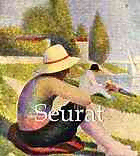
Georges Seurat PDF
Preview Georges Seurat
SSeeuurraatt Page 4: Georges-Pierre Seurat Photograph Author: Lucie Cousturier Layout: Baseline Co. Ltd 61A-63A Vo Van Tan Street 4thFloor District 3, Ho Chi Minh City Vietnam © Confidential Concepts, worldwide, USA © Parkstone Press International, New York, USA Image-Bar www.image-bar.com All rights reserved. No part of this publication may be reproduced or adapted without the permission of the copyright holder, throughout the world. Unless otherwise specified, copyright on the works reproduced lies with the respective photographers, artists, heirs or estates. Despite intensive research, it has not always been possible to establish copyright ownership. Where this is the case, we would appreciate notification. ISBN 978-1-78160-771-8 2 Art is harmony. Harmony is the analogy of contrasts, the analogy of similarities, of tone, of shade, of line, considered by the dominant, and under the influence of happy, calm, or sad lighting combinations. · Georges Seurat 3 Biography 1859: Georges-Pierre Seurat was born in Paris into a bourgeois family. His aunt was the wife of art dealer and amateur painter, Paul Homonté. This uncle was of particular influence to the young Georges as he introduced him to the practice of painting. Seurat was drawing from the age of nine. 1876: Seurat enrolled in the École Nationale des Beaux-Arts in Paris as an external auditor. 1878: Enrolled definitively in the École Nationale des Beaux-Arts in Paris in the department of painting. The painter Henri Lehmann (1814-1882), a former student of Ingres, was amongst his professors. It was during this period that Seurat read a scientific treaty on colours for the first time. He began with De la loi du contraste simultané de couleurs (1839) by the chemist Eugène Chevreul. 1879: Seurat opened a workshop with his friends Edmond Amand-Jean (who became a Symbolist painter) and Ernest Laurent who followed him into Neo-Impressionism. Together they visited the fourth Impressionist exhibition, and Seurat then decided to leave the Beaux-Arts. Georges left to complete his military service in Brest, returning one year later with numerous drawings of seascapes. 5 1882: He began to devote himself to the study of black and white and to the contrasts between colours, which would become the foundation for his artistic technique. 1884: Seurat exhibited his first big composition, Bathers at Asnières, at a salon for independent artists (Salon des Indépendants). There, he encountered painters who formed the Neo- Impressionist group. These included Charles Angrand, Maximilien Luce, Henri Cross, and Paul Signac. 1884-1890: During the summer, Seurat made several trips to Normandy, to the seaside, notably at Grandcamp-Maisy, Honfleur, and Port-en-Bessin. These seascapes were of great inspiration to him, and he brought back many paintings and drawings. 1886: He finished what is without doubt the most famous of his canvasses, A Sunday on La Grande Jatte, and exhibited it during the second Salon des Indépendants. 1890: His son, Pierre Georges, from his liaison with the model Medeleine Knobloch, was born. His family and friends consequently discovered this relationship, which had been previously kept hidden. March 1891: Georges Seurat died suddenly, most probably from diphtheria. His son died from the same illness a month later. 7 The Paintings If the fame which the names of Cézanne and Renoir have retained has bypassed Seurat, it is because the latterÊs works, which were immediately snapped up and fixed in private collections, have almost no contact with the public. Portrait of a Young Woman (The Artist’s Cousin?) c. 1877-1879 Oil on canvas, 30.4 x 25 cm The Dumbarton Oaks Research Library and Collections, Washington D.C 8 It was through successive works that the artistic innovators appeased the clamouring masses. Their total production of works is like a conversation which, by subtle styles and nuances, sways the viewers. Had Seurat continued to live beyond his thirty one years, nothing could today escape the domination of his work, which the vigour of his Woman on a Bench (Repairing her Coat) 1880-1881 Pencil, 16.5 x 10.4 cm Robert and Lisa Sainsbury Collection, Sainsbury Centre for Visual Arts, Norwich 10
